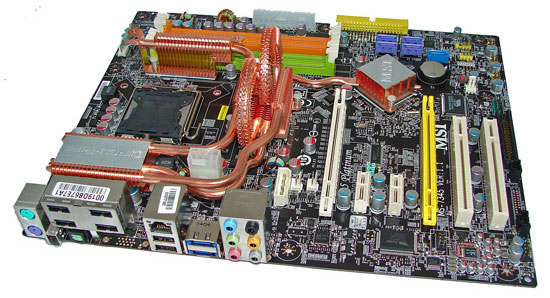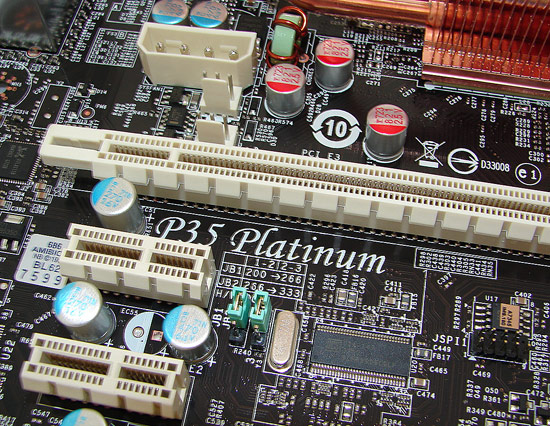Intel P35: Intel's Mainstream Chipset Grows Up
by Gary Key & Wesley Fink on May 21, 2007 3:45 PM EST- Posted in
- CPUs
MSI P35 Platinum Basic Features
| MSI P35 Platinum | |
| Market Segment: | Enthusiast - $199.99 |
| CPU Interface: | Socket T (Socket 775) |
| CPU Support: | LGA775-based Pentium 4, Celeron D, Pentium D, Pentium EE, Core 2 Duo, Core 2 Extreme |
| Chipset: | Intel P35 MCH and Intel ICH9R |
| Bus Speeds: | Auto, 200 ~ 600 in 1MHz increments |
| Memory Speed: DDR2 | Auto,1:1, 1:1.2, 1:2, 1:1.25, 1:1.66, 1:1.5 |
| PCIe Speeds: | Auto, 100MHz~200MHz in 1MHz Increments |
| Core Voltage: | Auto, 1.100V ~ 2.300V |
| SB Voltage: | 1.05V, 1.15V |
| SB I/O Voltage: | 1.50V ~1.80V in .05V increments |
| CPU Clock Multiplier: | Auto, 6x-50x in 1X increments if CPU is unlocked, downwards unlocked, Core 2 Duo |
| DRAM Voltage: DDR2 | Auto, 1.80V ~ 3.30V |
| DRAM Timing Control: | Auto, 9 DRAM Timing Options |
| NB Voltage: | Auto, 1.250V ~ 1.650V in .025V increments |
| FSB Voltage: | Auto, 1.175V ~ 1.500V in .025V increments |
| Memory Slots: | Four 240-pin DDR2 DIMM Slots Dual-Channel Configuration Regular Unbuffered Memory to 8GB Total |
| Expansion Slots: | 2 - PCIe X16 (1x16, 1x4 electrical for CrossFire or Multi-GPU) 2 - PCIe x1 2 - PCI Slot 2.2 |
| Onboard SATA/RAID: | 4 SATA 3Gbps Ports - ICH9R (RAID 0,1, 10, 5) 2 eSATA 3Gbps Port - ICH9R 1 SATA 3Gbps Port - Marvell 88SE6111 |
| Onboard IDE: | 1 ATA133/100/66 Port (2 drives) - Marvell 88SE6111 |
| Onboard USB 2.0/IEEE-1394: | 12 USB 2.0 Ports - 6 I/O Panel - 6 via Headers 2 Firewire 400 Ports by VIA VT6308 - 1 I/O Panel, 1 via Header |
| Onboard LAN: | Realtek RTL8111B PCIe Gigabit Ethernet controller |
| Onboard Audio: | Realtek ALC888 - 8-channel HD audio codec |
| Power Connectors: | ATX 24-pin, 8-pin EATX 12V, 4-pin Molex connector |
| I/O Panel: | 1 x PS/2 Keyboard 1 x PS/2 Mouse 2 x eSATA 1 x S/PDIF Optical - Out 1 x IEEE 1394a 1 x Audio Panel 1 x RJ45 6x USB 2.0/1.1 |
| BIOS Revision: | v.P01 |
| Board Revision: | v1.10 |
The MSI BIOS offers a decent set of options available for tweaking the board with specific emphasis placed on the available memory settings. Voltage options are rather limited but the range of voltage options available is impressive. Only our high end modules from OCZ, Corsair, and Patriot were able to operate at tight timings with absolute stability. However, until we received the latest BIOS release this weekend the board would not boot with 4GB of memory. MSI has made great strides over the past two weeks in getting this board to perform well with BIOS updates, and we fully expect the performance levels to match or come close to the other currently available P35 boards in the near future.
MSI P35 Platinum Board Layout and Features
 |
| Click to enlarge |
MSI did a really nice job in the layout of this board as all features on the board except for the floppy drive connector are easily reached. This board features a four-phase power regulation solution and conductive polymer aluminum capacitors that provided very good stability during testing. In a fight to outdo the other manufacturers in the heatpipe wars, MSI provided a roller coaster design that looks as interesting as it works. During our overclocking tests we found the heatpipe system results were on par with the other offerings provided additional airflow was available around the CPU area when using a cooler such as the Tuniq 120.

The board installed easily into our Cooler Master CM Stacker 830 case and cable management was very good for power, optical, and hard drives. Due to the tight clearances around the heatpipe, MSI includes an extender for the 8-pin ATX connector. We did not have any issues installing larger heat sinks on this board. The first DIMM slot is right against the rear heatpipe and the memory cannot be installed without removing the graphics card. MSI also includes a manual jumper system on the board that lets the user set a FSB speed of 200, 266, or 333 manually. The BIOS will automatically adjust settings to compensate for the change.










58 Comments
View All Comments
Gary Key - Tuesday, May 22, 2007 - link
X38 is basically ready, going through some fine tuning now... I understand it will be held until after the 1333CPUs are launched and DDR3 availability is a little more widespread/cost effective. I expect late August right now, but you never know with Intel. ;-)JarredWalton - Monday, May 21, 2007 - link
Technically Q3 is any time between July 1 and September 30, but if they're saying Q3 right now it probably means some time in August at best.gigahertz20 - Monday, May 21, 2007 - link
I applaud ASUS for only including 1 legacy connection on their P5K series, and not 4 like Gigabyte has chosen to do for their P35 board. Death to legacy connections!I mean really, why even include those damn legacy ports. The enthusiast that buys one of these boards will not be using them, they are a waste of space. Instead of having them, they should replace them with more USB ports or something useful.
JarredWalton - Monday, May 21, 2007 - link
I still have a parallel based laser printer that works fine for what I need, and I'm quite happy using it until it dies. There are also people that use serial devices that cost a lot of money. I don't think every board needs legacy support, but it's good that there are still options for people that *need* certain legacy devices. I've got several KVM switches that won't be useful if PS/2 ports disappear. :(yacoub - Monday, May 21, 2007 - link
Don't they offer USB or eSATA to serial/parallel convertors for those sort of situations? :)JarredWalton - Monday, May 21, 2007 - link
Sure, but I haven't had the need to try one yet. :)Truth be told, my printer has a USB port, but it behaves very poorly using a USB connection. It's a Brother HL-1240, and if the printer isn't powered on when you boot, Windows won't see it unless you unplug it and plug it back into a different USB port. It just works better with LPT, and as I said for my needs it's sufficient. The way I figure it, having the ports there isn't hurting most people. I've never seen anything to indicate they hamper performance, and how many extra transistors are "wasted" on these ports? Maybe a few thousand? Heheh. 45M transistors on the P35 is a bit crazy....
For what it's worth, between mouse, keyboard, and my LCD (which actually has four USB ports and flash memory readers), I haven't had any need for more than four USB ports on a motherboard. But then, I've got too many PCs around anyway.
TA152H - Monday, May 21, 2007 - link
I agree with you, but for another reason.I don't like USB at all, because a few years ago I ran some tests, on motherboards ranging from MVP3 based to a KT880, and USB seems to have a negative impact on performance, particularly on memory, in many cases.
It doesn't make my keyboard work any better, or my mouse, and I'm not sure why I need it for those functions at all. PS/2 ports don't do it well enough? I'm not crazy about this one size fits all approach, especially when it comes with overhead. The current ports work fine.
USB is a crappy, bloated technology. I'm not sure the "S" should stand for "serial" at all, I think there is a better word that begins with S for it.
strikeback03 - Tuesday, May 22, 2007 - link
Wake me up when Bluetooth works over PS/2.Though one reason to still include PS/2 keyboard/mouse is that it is hard to screw up support for those in Linux kernels. Same can't be said about USB.
TA152H - Tuesday, May 22, 2007 - link
Wake me up when I need Bluetooth.You could implement Bluetooth easily if USB didn't exist, but you're missing the point anyway. When you have to use USB for stuff that is handled more efficiently by PS/2 ports, it's a bad thing. Or other ports. It adds no function for these devices, and comes with overhead. It's a bad idea, but of course Intel was in the mode of making as many things as possible use CPU power so they could keep selling their latest and greatest.
It's just a rehash of some dorky Apple stuff that most people here don't remember. The original MacIntoy didn't have any slots, and you'd attach stuff to some serial bus for expansion. Naturally, it didn't work out, and they had to add slots. At least they didn't get rid of slots for USB, they just made it bloated.
DigitalFreak - Monday, May 21, 2007 - link
Man, if the P35 boards are going to be around the $250 mark, I'm not looking forward to see the price on the X38 boards.... :-(